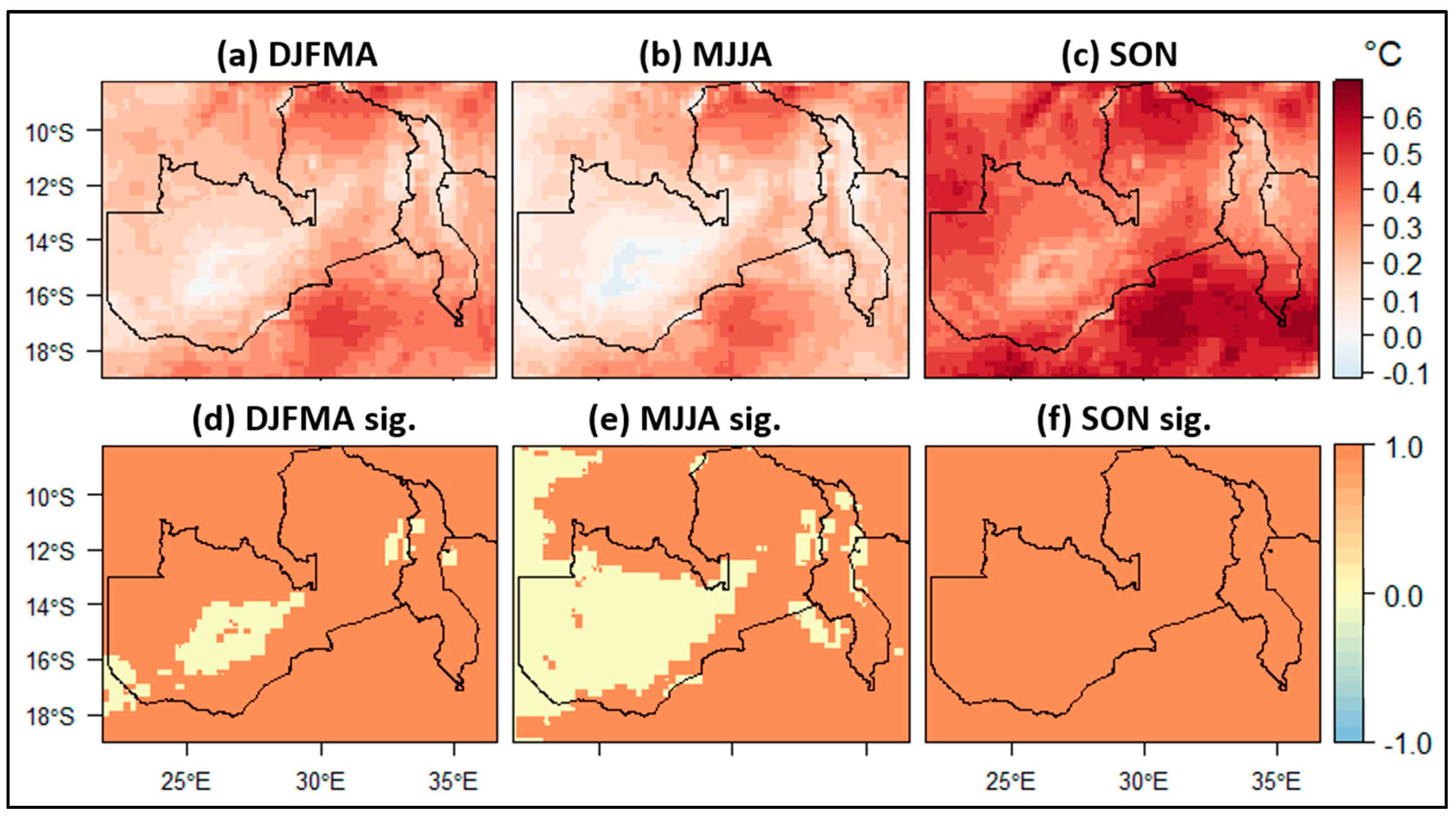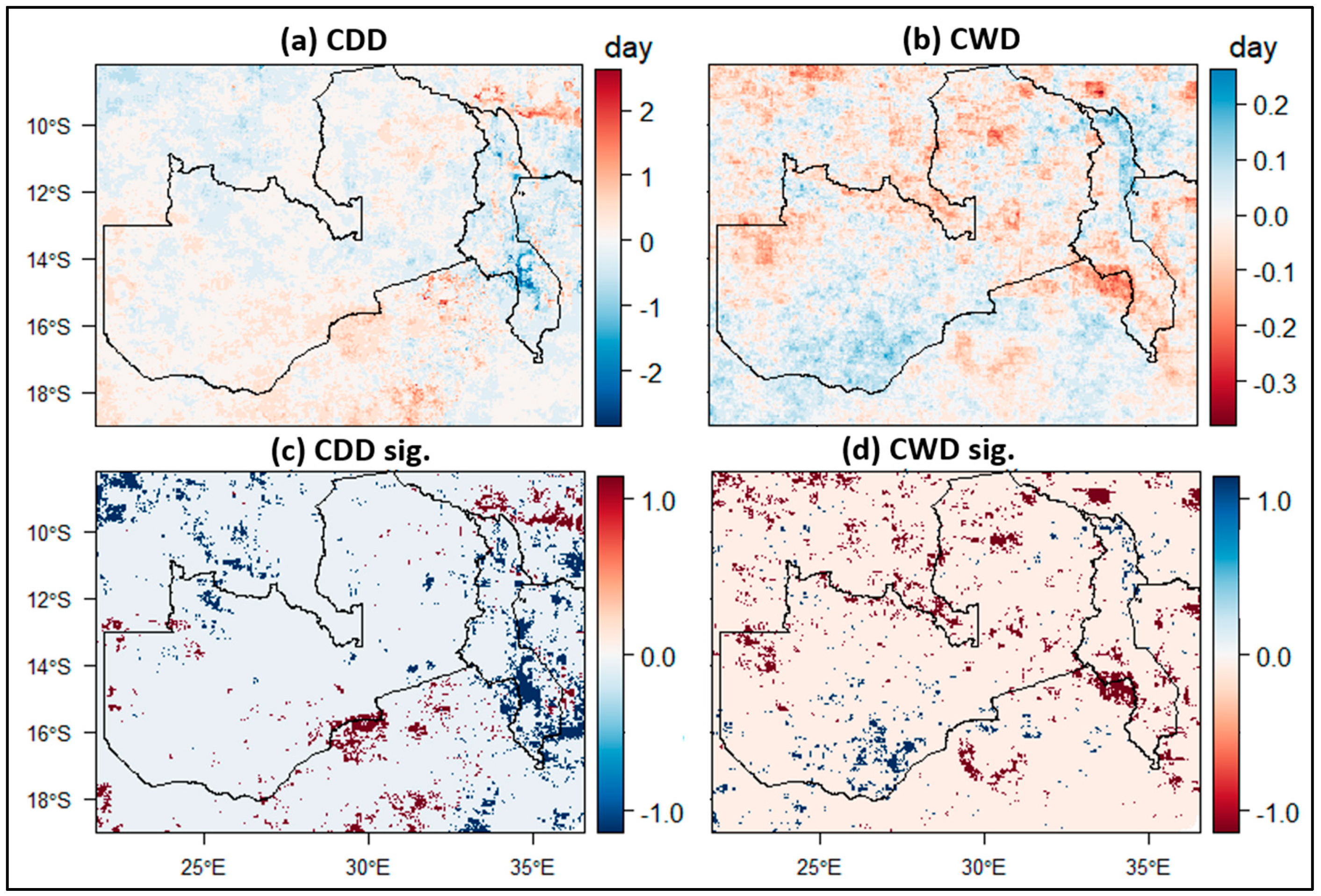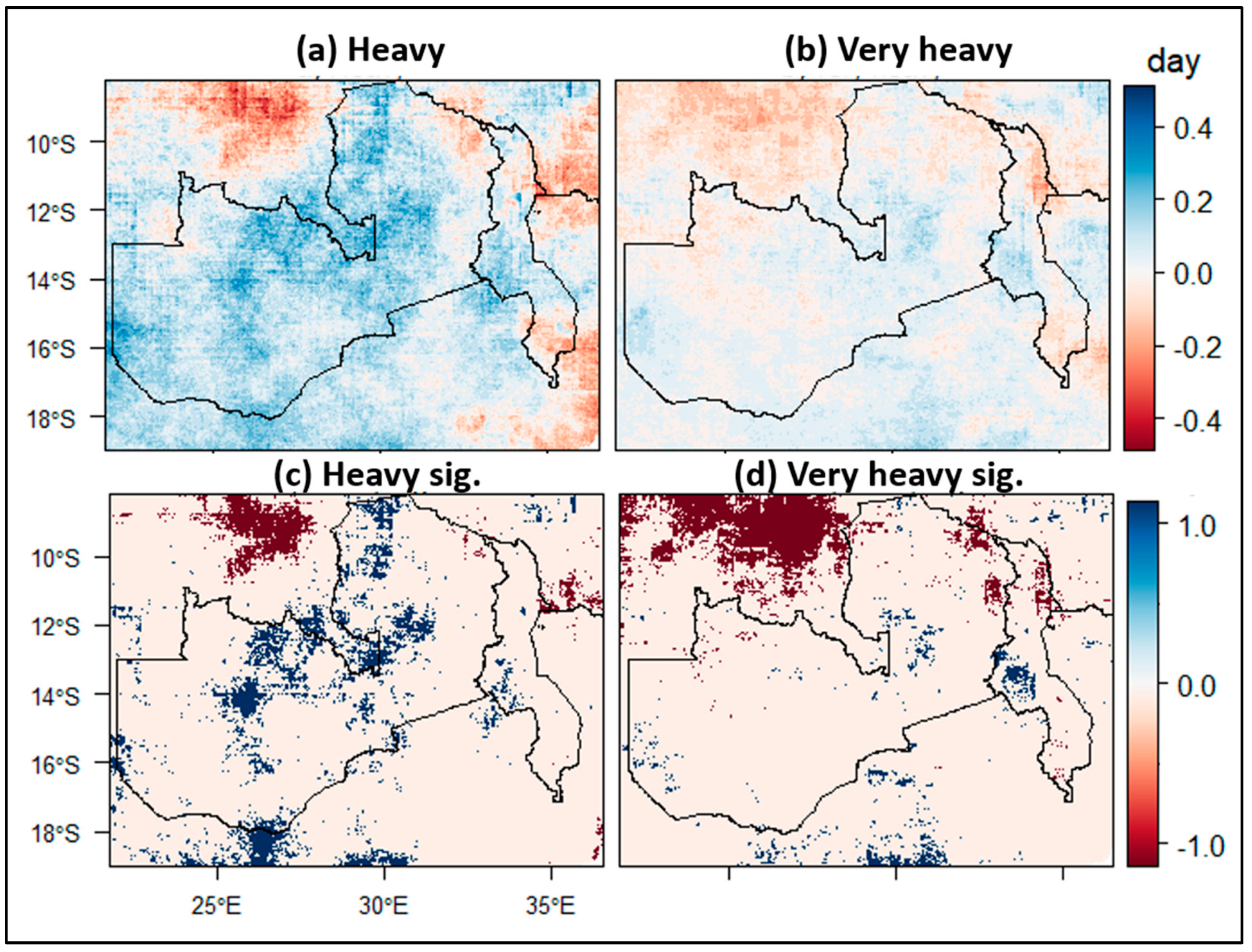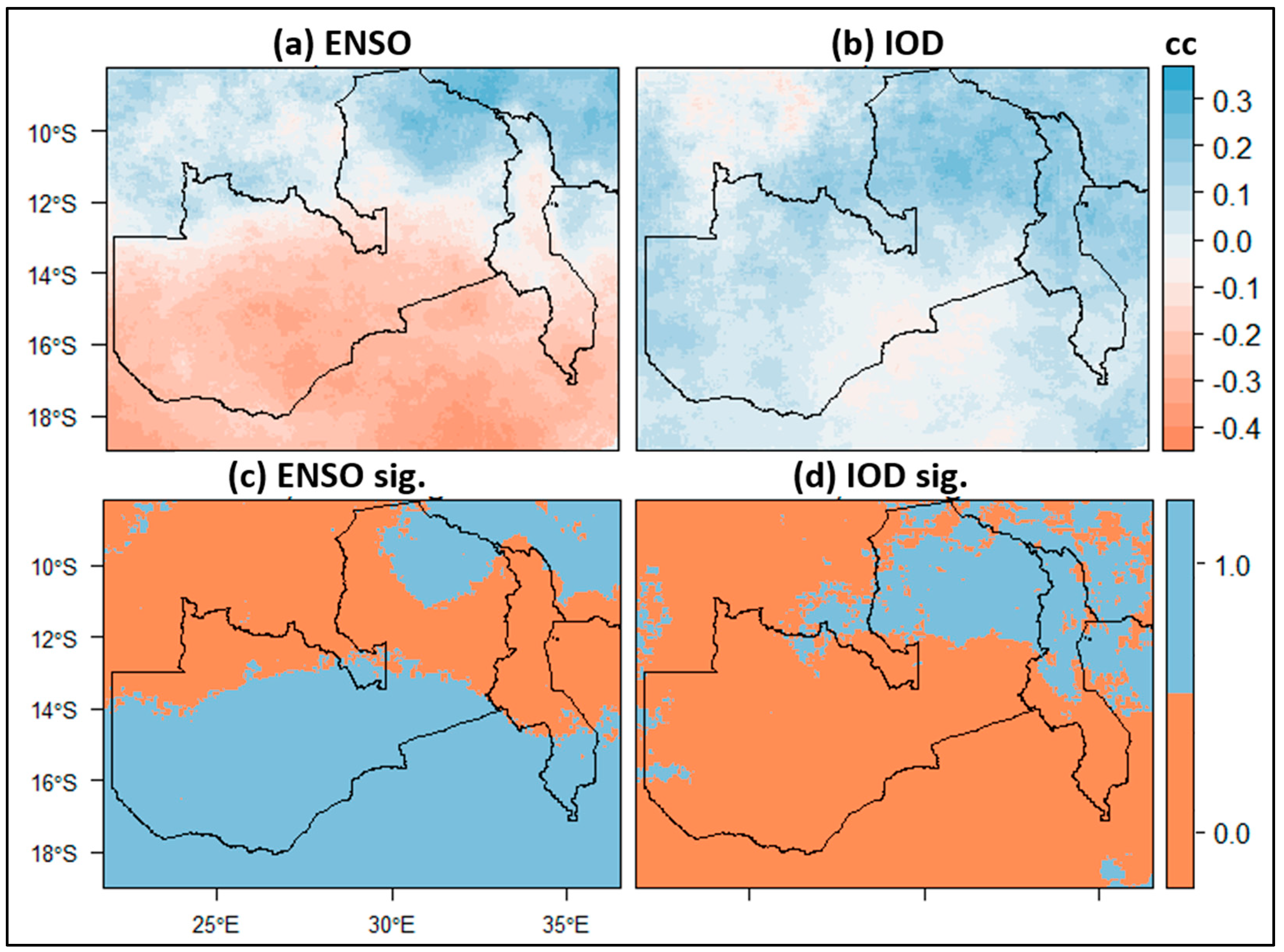Spatio-Temporal Trends in Precipitation, Temperature, and Extremes: A Study of Malawi and Zambia (1981–2021)
Abstract
:1. Introduction
2. Materials and Methods
2.1. Study Area and Data
2.2. Datasets
2.3. Methodology
3. Results
3.1. Annual Trends
3.2. Seasonal Trends
3.3. Climate Extremes
3.4. Impact of Large-Scale Climate Variables on Seasonal Rainfall Variability
4. Discussion
5. Conclusions
Author Contributions
Funding
Institutional Review Board Statement
Informed Consent Statement
Data Availability Statement
Acknowledgments
Conflicts of Interest
References
- Hewitson, B.; Janetos, A.C.; Carter, T.R.; Giorgi, F.; Jones, R.G.; Kwon, W.-T.; Mearns, L.O.; Schipper, E.L.F.; van Aalst, M. 2014: Regional context. In: Climate Change 2014: Impacts, Adaptation, and Vulnerability; Part B: Regional Aspects. Contribution of Working Group II to the Fifth Assessment Report of the Intergovernmental Panel on Climate Change; Barros, V.R., Field, C.B., Dokken, D.J., Mastrandrea, M.D., Mach, K.J., Bilir, T.E., Chatterjee, M., Ebi, K.L., Estrada, Y.O., Genova, R.C., et al., Eds.; Cambridge University Press: Cambridge, UK; New York, NY, USA, 2014; pp. 1133–1197. [Google Scholar]
- Solomon, S. (Ed.) IPCC Climate Change 2007: The Physical Science Basis; Cambridge University Press: Cambridge, UK, 2007; p. 1007. [Google Scholar]
- IPCC. IPCC Third Assessment Report: Climate Change 2001 (TAR); IPCC: Geneva, Switzerland, 2001. [Google Scholar]
- Masson-Delmotte, V.; Zhai, P.; Pirani, A.; Connors, S.L.; Péan, C.; Berger, S.; Caud, N.; Chen, Y.; Goldfarb, L.; Gomis, M.I.; et al. (Eds.) Climate Change 2021: The Physical Science Basis. Contribution of Working Group I to the Sixth Assessment Report of the Intergovernmental Panel on Climate Change; Cambridge University Press: Cambridge, UK, 2021. [Google Scholar]
- Abbass, K.; Qasim, M.Z.; Song, H.; Murshed, M.; Mahmood, H.; Younis, I. A Review of the Global Climate Change Impacts, Adaptation, and Sustainable Mitigation Measures. Environ. Sci. Pollut. Res. 2022, 29, 42539–42559. [Google Scholar] [CrossRef] [PubMed]
- Malhi, Y.; Franklin, J.; Seddon, N.; Solan, M.; Turner, M.G.; Field, C.B.; Knowlton, N. Climate Change and Ecosystems: Threats, Opportunities and Solutions. Philos. Trans. R. Soc. B Biol. Sci. 2020, 375, 20190104. [Google Scholar] [CrossRef] [PubMed]
- Nicholson, S.E.; Nash, D.J.; Chase, B.M.; Grab, S.W.; Shanahan, T.M.; Verschuren, D.; Asrat, A.; Lézine, A.-M.; Umer, M. Temperature Variability over Africa during the Last 2000 Years. Holocene 2013, 23, 1085–1094. [Google Scholar] [CrossRef]
- Gan, T.Y.; Ito, M.; Hülsmann, S.; Qin, X.; Lu, X.X.; Liong, S.Y.; Rutschman, P.; Disse, M.; Koivusalo, H. Possible Climate Change/Variability and Human Impacts, Vulnerability of Drought-Prone Regions, Water Resources and Capacity Building for Africa. Hydrol. Sci. J. 2016, 61, 1209–1226. [Google Scholar] [CrossRef]
- IPCC. AR6 Climate Change 2022: Impacts, Adaptation and Vulnerability; IPCC: Geneva, Switzerland, 2022. [Google Scholar]
- Sutton, M.A.; van Grinsven, H.; Billen, G.; Bleeker, A.; Bouwman, A.F.; Bull, K.; Erisman, J.W.; Grennfelt, P.; Grizzetti, B.; Howard, C.M.; et al. Summary for Policy Makers. In The European Nitrogen Assessment: Sources, Effects and Policy Perspectives; Bleeker, A., Grizzetti, B., Howard, C.M., Billen, G., van Grinsven, H., Erisman, J.W., Sutton, M.A., Grennfelt, P., Eds.; Cambridge University Press: Cambridge, UK, 2011; pp. xxiv–xxxiv. ISBN 978-1-107-00612-6. [Google Scholar]
- Niang, I.; Ruppel, O.C.; Abdrabo, M.A.; Essel, A.; Lennard, C.; Padgham, J.; Urquhart, P. Africa. In Climate Change 2014: Impacts, Adaptation, and Vulnerability; Barros, V.R., Ed.; Part B: Regional Aspects; Cambridge University Press: Cambridge, UK, 2014; pp. 1199–1265. [Google Scholar]
- Almazroui, M.; Saeed, F.; Saeed, S.; Nazrul Islam, M.; Ismail, M.; Klutse, N.A.B.; Siddiqui, M.H. Projected Change in Temperature and Precipitation Over Africa from CMIP6. Earth Syst. Environ. 2020, 4, 455–475. [Google Scholar] [CrossRef]
- Gebrechorkos, S.H.; Hülsmann, S.; Bernhofer, C. Long-Term Trends in Rainfall and Temperature Using High-Resolution Climate Datasets in East Africa. Sci. Rep. 2019, 9, 11376. [Google Scholar] [CrossRef] [PubMed]
- Gebrechorkos, S.H.; Hülsmann, S.; Bernhofer, C. Analysis of Climate Variability and Droughts in East Africa Using High-Resolution Climate Data Products. Glob. Planet. Chang. 2020, 186, 103130. [Google Scholar] [CrossRef]
- Haile, G.G.; Tang, Q.; Leng, G.; Jia, G.; Wang, J.; Cai, D.; Sun, S.; Baniya, B.; Zhang, Q. Long-Term Spatiotemporal Variation of Drought Patterns over the Greater Horn of Africa. Sci. Total Environ. 2020, 704, 135299. [Google Scholar] [CrossRef]
- Omambia, A.N.; Shemsanga, C.; Sanchez Hernandez, I.A. Climate Change Impacts, Vulnerability, and Adaptation in East Africa (EA) and South America (SA). In Handbook of Climate Change Mitigation; Chen, W.-Y., Seiner, J., Suzuki, T., Lackner, M., Eds.; Springer: New York, NY, USA, 2012; pp. 571–620. ISBN 978-1-4419-7991-9. [Google Scholar]
- WWF Climate Change Impacts on East Africa. A Review of the Scientific Literature; World Wide Fund For Nature: Washington, DC, USA, 2006. [Google Scholar]
- Haile, G.G.; Tang, Q.; Sun, S.; Huang, Z.; Zhang, X.; Liu, X. Droughts in East Africa: Causes, Impacts and Resilience. Earth-Sci. Rev. 2019, 193, 146–161. [Google Scholar] [CrossRef]
- Gebrechorkos, S.H.; Hülsmann, S.; Bernhofer, C. Changes in Temperature and Precipitation Extremes in Ethiopia, Kenya, and Tanzania. Int. J. Climatol. 2019, 39, 18–30. [Google Scholar] [CrossRef]
- Bradshaw, C.D.; Pope, E.; Kay, G.; Davie, J.C.S.; Cottrell, A.; Bacon, J.; Cosse, A.; Dunstone, N.; Jennings, S.; Challinor, A.; et al. Unprecedented Climate Extremes in South Africa and Implications for Maize Production. Environ. Res. Lett. 2022, 17, 084028. [Google Scholar] [CrossRef]
- Ficchì, A.; Cloke, H.; Neves, C.; Woolnough, S.; Coughlan de Perez, E.; Zsoter, E.; Pinto, I.; Meque, A.; Stephens, E. Beyond El Niño: Unsung Climate Modes Drive African Floods. Weather. Clim. Extrem. 2021, 33, 100345. [Google Scholar] [CrossRef]
- Ogwang, B.; Ongoma, V.; Shilenje, Z.W.; Ramotubei, T.; Letuma, M.; Ngaina, J. Influence of Indian Ocean Dipole on Rainfall Variability and Extremes over Southern Africa. Mausam 2020, 71, 637–648. [Google Scholar] [CrossRef]
- Rouault, M.; Monyela, B.; Imbol Koungue, R.A.; Imbol Nkwinkwa, A.S.N.; Dieppois, B.; Illig, S.; Keenlyside, N. Ocean Impact on Southern African Climate Variability and Water Resources; Water Research Commission: Pretoria, South Africa, 2019. [Google Scholar]
- Fer, I.; Tietjen, B.; Jeltsch, F.; Wolff, C. The Influence of El Niño–Southern Oscillation Regimes on Eastern African Vegetation and Its Future Implications under the RCP8.5 Warming Scenario. Biogeosciences 2017, 14, 4355–4374. [Google Scholar] [CrossRef]
- Mpelasoka, F.; Awange, J.L.; Zerihun, A. Influence of Coupled Ocean-Atmosphere Phenomena on the Greater Horn of Africa Droughts and Their Implications. Sci. Total Environ. 2018, 610–611, 691–702. [Google Scholar] [CrossRef]
- Endris, H.S.; Lennard, C.; Hewitson, B.; Dosio, A.; Nikulin, G.; Artan, G.A. Future Changes in Rainfall Associated with ENSO, IOD and Changes in the Mean State over Eastern Africa. Clim. Dyn. 2018, 52, 2029–2053. [Google Scholar] [CrossRef]
- Tierney, J.E.; Ummenhofer, C.C.; deMenocal, P.B. Past and Future Rainfall in the Horn of Africa. Sci. Adv. 2015, 1, e1500682. [Google Scholar] [CrossRef]
- Gebrechorkos, S.H.; Taye, M.T.; Birhanu, B.; Solomon, D.; Demissie, T. Future Changes in Climate and Hydroclimate Extremes in East Africa. Earth’s Future, 2023; 11, e2022EF003011. [Google Scholar] [CrossRef]
- Palmer, P.I.; Wainwright, C.M.; Dong, B.; Maidment, R.I.; Wheeler, K.G.; Gedney, N.; Hickman, J.E.; Madani, N.; Folwell, S.S.; Abdo, G.; et al. Drivers and Impacts of Eastern African Rainfall Variability. Nat. Rev. Earth Environ. 2023, 4, 254–270. [Google Scholar] [CrossRef]
- Park, S.; Kang, D.; Yoo, C.; Im, J.; Lee, M.-I. Recent ENSO Influence on East African Drought during Rainy Seasons through the Synergistic Use of Satellite and Reanalysis Data. ISPRS J. Photogramm. Remote Sens. 2020, 162, 17–26. [Google Scholar] [CrossRef]
- Blau, M.T.; Ha, K.-J. The Indian Ocean Dipole and Its Impact on East African Short Rains in Two CMIP5 Historical Scenarios with and Without Anthropogenic Influence. J. Geophys. Res. Atmos. 2020, 125, e2020JD033121. [Google Scholar] [CrossRef]
- Wainwright, C.M.; Finney, D.L.; Kilavi, M.; Black, E.; Marsham, J.H. Extreme Rainfall in East Africa, October 2019–January 2020 and Context under Future Climate Change. Weather 2021, 76, 26–31. [Google Scholar] [CrossRef]
- Funk, C.; Dettinger, M.D.; Michaelsen, J.C.; Verdin, J.P.; Brown, M.E.; Barlow, M.; Hoell, A. Warming of the Indian Ocean Threatens Eastern and Southern African Food Security but Could Be Mitigated by Agricultural Development. Proc. Natl. Acad. Sci. USA 2008, 105, 11081–11086. [Google Scholar] [CrossRef] [PubMed]
- Ngcamu, B.S.; Chari, F. Drought Influences on Food Insecurity in Africa: A Systematic Literature Review. Int. J. Environ. Res. Public Health 2020, 17, 5897. [Google Scholar] [CrossRef]
- FAO. The State of Food Insecurity in the World (SOFI); Food and Agricultural Organization of the United Nations and World Bank: Rome, Italy, 2014. [Google Scholar]
- Mahoo, H.F.; Radeny, M.A.O.; Kinyangi, J.; Cramer, L. Climate Change Vulnerability and Risk Assessment of Agriculture and Food Security in Ethiopia: Which Way Forward? Working Paper No. 59. CCAFS Working Paper 2013. Available online: https://cgspace.cgiar.org/items/3ab9835e-26e6-42e7-8a85-15bf7bdb6dc4 (accessed on 21 January 2024).
- Kotir, J.H. Climate Change and Variability in Sub-Saharan Africa: A Review of Current and Future Trends and Impacts on Agriculture and Food Security. Environ. Dev. Sustain. 2011, 13, 587–605. [Google Scholar] [CrossRef]
- Nicol, A.; Langan, S.J.; Victor, M.; Gonsalves, J.F. Water-Smart Agriculture in East Africa; CGIAR Research Program on Water, Land and Ecosystems; International Water Management Institute: Colombo, Sri Lanka, 2015; ISBN 978-92-9090-813-5. [Google Scholar]
- Emediegwu, L.E.; Wossink, A.; Hall, A. The Impacts of Climate Change on Agriculture in Sub-Saharan Africa: A Spatial Panel Data Approach. World Dev. 2022, 158, 105967. [Google Scholar] [CrossRef]
- CDKN. The IPCC’s Fifth Assessment Report: Whats in It for Africa; CDKN: London, UK, 2014; p. 79. [Google Scholar]
- Saimi, F.M.; Hamzah, F.M.; Toriman, M.E.; Jaafar, O.; Tajudin, H. Trend and Linearity Analysis of Meteorological Parameters in Peninsular Malaysia. Sustainability 2020, 12, 9533. [Google Scholar] [CrossRef]
- Chisanga, C.B.; Nkonde, E.; Phiri, E.; Mubanga, K.H.; Lwando, C. Trend Analysis of Rainfall from 1981–2022 over Zambia. Heliyon 2023, 9, e22345. [Google Scholar] [CrossRef]
- Tadeyo, E.; Chen, D.; Ayugi, B.; Yao, C. Characterization of Spatio-Temporal Trends and Periodicity of Precipitation over Malawi during 1979–2015. Atmosphere 2020, 11, 891. [Google Scholar] [CrossRef]
- Beck, H.E.; Zimmermann, N.E.; McVicar, T.R.; Vergopolan, N.; Berg, A.; Wood, E.F. Present and Future Köppen-Geiger Climate Classification Maps at 1-Km Resolution. Sci. Data 2018, 5, 180214. [Google Scholar] [CrossRef]
- Funk, C.; Peterson, P.; Landsfeld, M.; Pedreros, D.; Verdin, J.; Shukla, S.; Husak, G.; Rowland, J.; Harrison, L.; Hoell, A.; et al. The Climate Hazards Infrared Precipitation with Stations—A New Environmental Record for Monitoring Extremes. Sci. Data 2015, 2, 150066. [Google Scholar] [CrossRef] [PubMed]
- Beck, H.E.; Dijk, A.I.J.M.V.; Larraondo, P.R.; McVicar, T.R.; Pan, M.; Dutra, E.; Miralles, D.G. MSWX: Global 3-Hourly 0.1° Bias-Corrected Meteorological Data Including Near-Real-Time Updates and Forecast Ensembles. Bull. Am. Meteorol. Soc. 2022, 103, E710–E732. [Google Scholar] [CrossRef]
- Gebrechorkos, S.H.; Hülsmann, S.; Bernhofer, C. Evaluation of Multiple Climate Data Sources for Managing Environmental Resources in East Africa. Hydrol. Earth Syst. Sci. 2018, 22, 4547–4564. [Google Scholar] [CrossRef]
- Dinku, T.; Funk, C.; Peterson, P.; Maidment, R.; Tadesse, T.; Gadain, H.; Ceccato, P. Validation of the CHIRPS Satellite Rainfall Estimates over Eastern Africa. Q. J. R. Meteorol. Soc. 2018, 144, 292–312. [Google Scholar] [CrossRef]
- AL-Falahi, A.H.; Saddique, N.; Spank, U.; Gebrechorkos, S.H.; Bernhofer, C. Evaluation the Performance of Several Gridded Precipitation Products over the Highland Region of Yemen for Water Resources Management. Remote Sens. 2020, 12, 2984. [Google Scholar] [CrossRef]
- Harris, I.; Jones, P.D.; Osborn, T.J.; Lister, D.H. Updated High-Resolution Grids of Monthly Climatic Observations—The CRU TS3.10 Dataset. Int. J. Climatol. 2014, 34, 623–642. [Google Scholar] [CrossRef]
- Karger, D.N.; Conrad, O.; Böhner, J.; Kawohl, T.; Kreft, H.; Soria-Auza, R.W.; Zimmermann, N.E.; Linder, H.P.; Kessler, M. Climatologies at High Resolution for the Earth’s Land Surface Areas. Sci. Data 2017, 4, 170122. [Google Scholar] [CrossRef]
- Hargreaves, G.; Samani, Z. Reference Crop Evapotranspiration from Temperature. Appl. Eng. Agric. 1985, 1, 96–99. [Google Scholar] [CrossRef]
- Taye, M.T.; Willems, P. Identifying Sources of Temporal Variability in Hydrological Extremes of the Upper Blue Nile Basin. J. Hydrol. 2013, 499, 61–70. [Google Scholar] [CrossRef]
- Karl, T.R.; Nicholls, N.; Ghazi, A. CLIVAR/GCOS/WMO Workshop on Indices and Indicators for Climate Extremes Workshop Summary. In Weather and Climate Extremes: Changes, Variations and a Perspective from the Insurance Industry; Karl, T.R., Nicholls, N., Ghazi, A., Eds.; Springer: Dordrecht, The Netherlands, 1999; pp. 3–7. ISBN 978-94-015-9265-9. [Google Scholar]
- Schulzweida, U.; Kornblueh, L. Ralf Quast CDO—Climate Data Operators—Project Management Service 2009. Available online: https://code.mpimet.mpg.de/projects/cdo (accessed on 21 January 2024).
- Kendall, M.G. Rank Correlation Methods, 4th ed.; Charles Griffin: London, UK, 1975; Available online: https://search.worldcat.org/title/Rank-correlation-methods/oclc/3827024 (accessed on 21 January 2024).
- Sen, P.K. Estimates of the Regression Coefficient Based on Kendall’s Tau. J. Am. Stat. Assoc. 1968, 63, 1379–1389. [Google Scholar] [CrossRef]
- Navarro-Racines, C.; Tarapues, J.; Thornton, P.; Jarvis, A.; Ramirez-Villegas, J. High-Resolution and Bias-Corrected CMIP5 Projections for Climate Change Impact Assessments. Sci. Data 2020, 7, 7. [Google Scholar] [CrossRef]
- Wang, Y.; Karimi, H.A. Generating High-Resolution Climatological Precipitation Data Using SinGAN. Big Earth Data 2023, 7, 81–100. [Google Scholar] [CrossRef]
- Chakraborty, D.; Dobor, L.; Zolles, A.; Hlásny, T.; Schueler, S. High-Resolution Gridded Climate Data for Europe Based on Bias-Corrected EURO-CORDEX: The ECLIPS Dataset. Geosci. Data J. 2021, 8, 121–131. [Google Scholar] [CrossRef]
- du Plessis, J.A.; Kibii, J.K. Applicability of CHIRPS-Based Satellite Rainfall Estimates for South Africa. J. South Afr. Inst. Civ. Eng. 2021, 63, 43–54. [Google Scholar] [CrossRef]
- Kouakou, C.; Paturel, J.-E.; Satgé, F.; Tramblay, Y.; Defrance, D.; Rouché, N. Comparison of Gridded Precipitation Estimates for Regional Hydrological Modeling in West and Central Africa. J. Hydrol. Reg. Stud. 2023, 47, 101409. [Google Scholar] [CrossRef]
- Muthoni, F.K.; Odongo, V.O.; Ochieng, J.; Mugalavai, E.M.; Mourice, S.K.; Hoesche-Zeledon, I.; Mwila, M.; Bekunda, M. Long-Term Spatial-Temporal Trends and Variability of Rainfall over Eastern and Southern Africa. Theor. Appl. Climatol. 2019, 137, 1869–1882. [Google Scholar] [CrossRef]
- Haghtalab, N.; Moore, N.; Ngongondo, C. Spatio-Temporal Analysis of Rainfall Variability and Seasonality in Malawi. Reg. Environ. Chang. 2019, 19, 2041–2054. [Google Scholar] [CrossRef]
- Maidment, R.I.; Allan, R.P.; Black, E. Recent Observed and Simulated Changes in Precipitation over Africa. Geophys. Res. Lett. 2015, 42, 8155–8164. [Google Scholar] [CrossRef]
- Nash, D.J.; Pribyl, K.; Endfield, G.H.; Klein, J.; Adamson, G.C.D. Rainfall Variability over Malawi during the Late 19th Century. Int. J. Climatol. 2018, 38, e629–e642. [Google Scholar] [CrossRef]
- Kumbuyo, C.P.; Yasuda, H.; Kitamura, Y.; Shimizu, K. Fluctuation of Rainfall Time Series in Malawi: An Analysis of Selected Areas. Geofizika 2014, 31, 13–28. [Google Scholar] [CrossRef]
- Jiang, Y.; Zhou, L.; Roundy, P.E.; Hua, W.; Raghavendra, A. Increasing Influence of Indian Ocean Dipole on Precipitation Over Central Equatorial Africa. Geophys. Res. Lett. 2021, 48, e2020GL092370. [Google Scholar] [CrossRef]
- Diedhiou, A.; Bichet, A.; Wartenburger, R.; Seneviratne, S.I.; Rowell, D.P.; Sylla, M.B.; Diallo, I.; Todzo, S.; Touré, N.E.; Camara, M.; et al. Changes in Climate Extremes over West and Central Africa at 1.5 °C and 2 °C Global Warming. Environ. Res. Lett. 2018, 13, 065020. [Google Scholar] [CrossRef]
- Omondi, P.A.; Awange, J.L.; Forootan, E.; Ogallo, L.A.; Barakiza, R.; Girmaw, G.B.; Fesseha, I.; Kululetera, V.; Kilembe, C.; Mbati, M.M.; et al. Changes in Temperature and Precipitation Extremes over the Greater Horn of Africa Region from 1961 to 2010. Int. J. Climatol. 2014, 34, 1262–1277. [Google Scholar] [CrossRef]
- Mengistu, A.G.; Woyessa, Y.E.; Tesfuhuney, W.A.; Steyn, A.S.; Lee, S.S. Assessing the Impact of Climate Change on Future Extreme Temperature Events in Major South African Cities. Theor. Appl. Climatol. 2023, 155, 1807–1819. [Google Scholar] [CrossRef]
- Bedair, H.; Alghariani, M.S.; Omar, E.; Anibaba, Q.A.; Remon, M.; Bornman, C.; Kiboi, S.K.; Rady, H.A.; Salifu, A.-M.A.; Ghosh, S.; et al. Global Warming Status in the African Continent: Sources, Challenges, Policies, and Future Direction. Int. J. Environ. Res. 2023, 17, 45. [Google Scholar] [CrossRef]
- Engdaw, M.M.; Ballinger, A.P.; Hegerl, G.C.; Steiner, A.K. Changes in Temperature and Heat Waves over Africa Using Observational and Reanalysis Data Sets. Int. J. Climatol. 2022, 42, 1165–1180. [Google Scholar] [CrossRef]
- Adhikari, U.; Nejadhashemi, A.P.; Woznicki, S.A. Climate Change and Eastern Africa: A Review of Impact on Major Crops. Food Energy Secur. 2015, 4, 110–132. [Google Scholar] [CrossRef]
- Camberlin, P. Temperature Trends and Variability in the Greater Horn of Africa: Interactions with Precipitation. Clim. Dyn. 2017, 48, 477–498. [Google Scholar] [CrossRef]
- Funk, C. USGS Fact Sheet 2010–3074: A Climate Trend Analysis of Kenya; U.S. Geological Survey Earth Resources Observation and Science: Sioux Falls, SD, USA, 2010.
- Gebrechorkos, S.H.; Hülsmann, S.; Bernhofer, C. Regional Climate Projections for Impact Assessment Studies in East Africa. Environ. Res. Lett. 2019, 14, 044031. [Google Scholar] [CrossRef]
- Ayugi, B.O.; Chung, E.-S.; Zhu, H.; Ogega, O.M.; Babousmail, H.; Ongoma, V. Projected Changes in Extreme Climate Events over Africa under 1.5 °C, 2.0 °C and 3.0 °C Global Warming Levels Based on CMIP6 Projections. Atmos. Res. 2023, 292, 106872. [Google Scholar] [CrossRef]
- Kikstra, J.; Nicholls, Z.; Smith, C.; Lewis, J.; Lamboll, R.; Byers, E.; Sandstad, M.; Meinshausen, M.; Gidden, M.; Rogelj, J.; et al. The IPCC Sixth Assessment Report WGIII Climate Assessment of Mitigation Pathways: From Emissions to Global Temperatures. Geosci. Model Dev. 2022, 15, 9075–9109. [Google Scholar] [CrossRef]
- Majdi, F.; Hosseini, S.A.; Karbalaee, A.; Kaseri, M.; Marjanian, S. Future Projection of Precipitation and Temperature Changes in the Middle East and North Africa (MENA) Region Based on CMIP6. Theor. Appl. Climatol. 2022, 147, 1249–1262. [Google Scholar] [CrossRef]
- AL-Falahi, A.H.; Barry, S.; Gebrechorkos, S.H.; Spank, U.; Bernhofer, C. Potential of Traditional Adaptation Measures in Mitigating the Impact of Climate Change. Sustainability 2023, 15, 15442. [Google Scholar] [CrossRef]










| Index | Definition | Unit |
|---|---|---|
| CDD | Consecutive Dry Day (CDD): maximum number of consecutive days with daily precipitation below 1 mm (maximum length of dry spell). | days |
| CWD | Consecutive Wet Day (CWD): maximum number of consecutive days with daily precipitation greater than 1 mm (maximum length of wet spell). | days |
| R10mm | Heavy precipitation days: total number of days with daily precipitation greater than 10 mm. | days |
| R20mm | Very heavy precipitation days: total number of days with daily precipitation greater than 20 mm. | days |
| Heatwave | Heatwave duration: number of six consecutive days when the daily maximum temperature exceeds the mean reference period by 5 °C. | days |
Disclaimer/Publisher’s Note: The statements, opinions and data contained in all publications are solely those of the individual author(s) and contributor(s) and not of MDPI and/or the editor(s). MDPI and/or the editor(s) disclaim responsibility for any injury to people or property resulting from any ideas, methods, instructions or products referred to in the content. |
© 2024 by the authors. Licensee MDPI, Basel, Switzerland. This article is an open access article distributed under the terms and conditions of the Creative Commons Attribution (CC BY) license (https://creativecommons.org/licenses/by/4.0/).
Share and Cite
Demissie, T.; Gebrechorkos, S.H. Spatio-Temporal Trends in Precipitation, Temperature, and Extremes: A Study of Malawi and Zambia (1981–2021). Sustainability 2024, 16, 3885. https://doi.org/10.3390/su16103885
Demissie T, Gebrechorkos SH. Spatio-Temporal Trends in Precipitation, Temperature, and Extremes: A Study of Malawi and Zambia (1981–2021). Sustainability. 2024; 16(10):3885. https://doi.org/10.3390/su16103885
Chicago/Turabian StyleDemissie, Teferi, and Solomon H. Gebrechorkos. 2024. "Spatio-Temporal Trends in Precipitation, Temperature, and Extremes: A Study of Malawi and Zambia (1981–2021)" Sustainability 16, no. 10: 3885. https://doi.org/10.3390/su16103885





